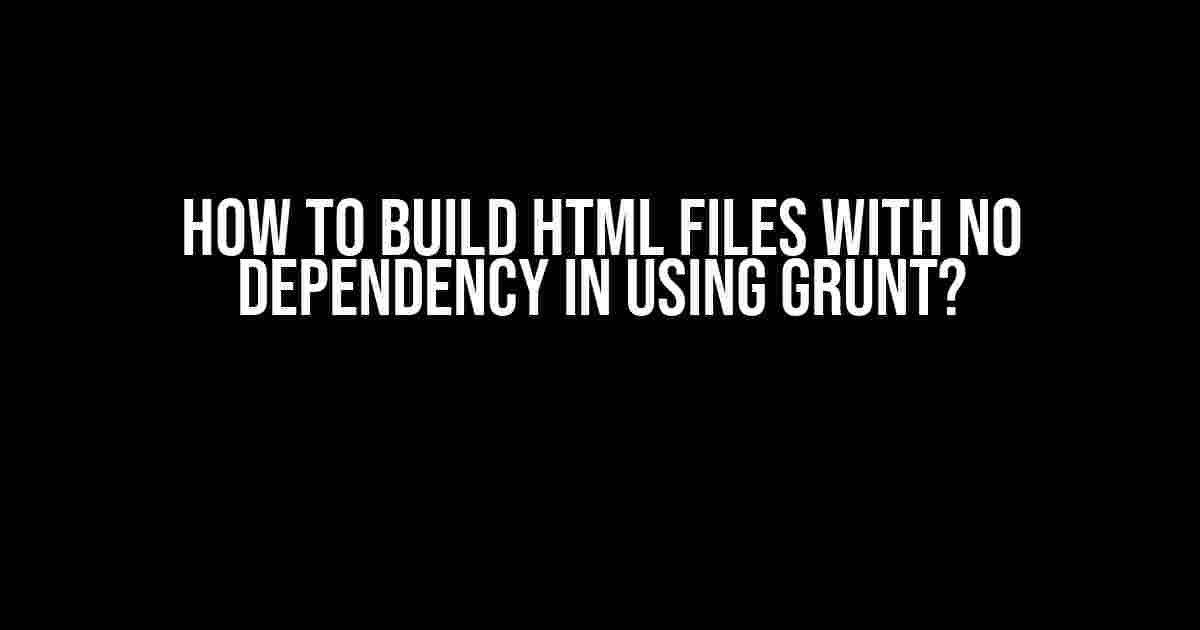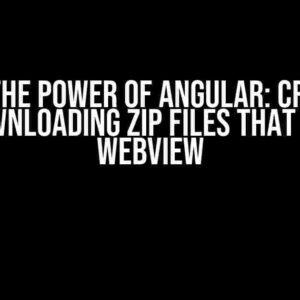Are you tired of dealing with dependencies while building HTML files? Do you want to streamline your frontend development process? Look no further! In this comprehensive guide, we’ll show you how to use Grunt to build HTML files with no dependency. Yes, you read that right – no dependency!
What is Grunt?
Grunt is a popular JavaScript task runner that helps you automate repetitive tasks, such as minifying code, concatenating files, and optimizing images. It’s a powerful tool that can save you time and effort in your frontend development workflow.
Why Use Grunt for Building HTML Files?
There are several reasons why you should use Grunt for building HTML files:
- Faster Development: Grunt automates many tasks, allowing you to focus on writing code instead of manual processing.
- Efficient Code: Grunt helps you optimize your code, reducing file sizes and improving page load times.
- Easy Maintenance: With Grunt, you can easily manage and update your HTML files, even when working on large projects.
Setting Up Grunt
- Install Node.js and npm (the package manager for Node.js) on your system.
- Open your terminal or command prompt and install Grunt by running the command:
npm install -g grunt-cli - Create a new project directory and navigate to it using the terminal or command prompt.
- Run the command
npm initto create apackage.jsonfile. - Install Grunt locally by running the command:
npm install grunt
Creating a Gruntfile
A Gruntfile is a JavaScript file that contains the configuration and tasks for your project. Create a new file called Gruntfile.js in your project directory and add the following code:
module.exports = function(grunt) {
grunt.initConfig({
pkg: grunt.file.readJSON('package.json'),
});
};
This basic Gruntfile initializes Grunt and reads the package.json file.
Building HTML Files with No Dependency
Now that we have Grunt set up, let’s create a new HTML file called index.html in our project directory:
<!DOCTYPE html> <html> <head> <title>My HTML File</title> </head> <body> <h1>Hello World!</h1> </body> </html>
To build this HTML file with no dependency, we’ll use the Grunt htmlhint and htmlmin plugins. These plugins help us validate and optimize our HTML code. Install the plugins by running the following commands:
npm install grunt-htmlhint npm install grunt-htmlmin
Update your Gruntfile to include the following tasks:
module.exports = function(grunt) {
grunt.initConfig({
pkg: grunt.file.readJSON('package.json'),
htmlhint: {
build: {
src: ['index.html'],
options: {
htmlhintrc: '.htmlhintrc'
}
}
},
htmlmin: {
build: {
src: 'index.html',
dest: 'build/index.html'
}
}
});
grunt.loadNpmTasks('grunt-htmlhint');
grunt.loadNpmTasks('grunt-htmlmin');
grunt.registerTask('build', ['htmlhint', 'htmlmin']);
};
In this updated Gruntfile, we’ve added two tasks: htmlhint and htmlmin. The htmlhint task validates our HTML code, while the htmlmin task minifies and optimizes the code.
Running the Build Task
Run the following command to build our HTML file with no dependency:
grunt build
This command will execute the htmlhint and htmlmin tasks, resulting in a optimized HTML file in the build directory.
Understanding the Build Process
Let’s take a closer look at what happens during the build process:
| Task | Description |
|---|---|
| htmlhint | Validates the HTML code, checking for errors and warnings. |
| htmlmin | Minifies and optimizes the HTML code, reducing file size and improving page load times. |
By using these two tasks, we can ensure that our HTML file is error-free and optimized for production.
Conclusion
In this comprehensive guide, we’ve shown you how to build HTML files with no dependency using Grunt. By leveraging the power of Grunt and its plugins, you can streamline your frontend development workflow, automate repetitive tasks, and create optimized HTML files.
Remember, Grunt is a powerful tool that can be used for a wide range of tasks, from minifying code to optimizing images. By understanding how to use Grunt effectively, you can take your frontend development skills to the next level.
Final Tips and Tricks
Here are some final tips and tricks to keep in mind when working with Grunt:
- Always keep your Gruntfile organized and easy to read.
- Use Grunt plugins to automate specific tasks, such as minifying code or optimizing images.
- Take advantage of Grunt’s built-in tasks, such as
grunt-contrib-watch, to automate repetitive tasks. - Experiment with different Grunt plugins and tasks to find the perfect workflow for your project.
With Grunt, the possibilities are endless! Start building your HTML files with no dependency today and take your frontend development skills to new heights.
Frequently Asked Questions
Get ready to unlock the secrets of building HTML files with no dependency using Grunt!
What is the basic requirement to build HTML files with no dependency using Grunt?
To get started, you’ll need to have Node.js installed on your system, along with Grunt CLI. You can install Grunt CLI by running the command `npm install -g grunt-cli` in your terminal. Once you have Grunt set up, create a new project folder and navigate to it in your terminal.
How do I configure Grunt to build HTML files with no dependency?
In your project folder, create a new file called `gruntfile.js`. This file is where you’ll define your Grunt tasks. In your `gruntfile.js`, you’ll need to require the `grunt` module and configure the `htmlbuild` task to specify the source and destination files. For example: `grunt.loadNpmTasks(‘grunt-html-build’);` and `grunt.initConfig({ htmlbuild: { dist: { src: ‘src/index.html’, dest: ‘dist/index.html’ } } });`.
What is the role of the htmlbuild task in building HTML files with no dependency?
The `htmlbuild` task is responsible for building and concatenating your HTML files. It takes your source HTML file, processes it, and outputs a single, dependency-free HTML file to your specified destination. You can customize the task to suit your needs by adding options such as file compression and template engine support.
How do I run the Grunt task to build my HTML file?
To run the Grunt task, simply navigate to your project folder in your terminal and type `grunt htmlbuild`. This will execute the `htmlbuild` task and generate your output HTML file in the specified destination folder. You can also register a default task by adding `grunt.registerTask(‘default’, [‘htmlbuild’]);` to your `gruntfile.js`, allowing you to run the task with just `grunt`.
What are some benefits of building HTML files with no dependency using Grunt?
Building HTML files with no dependency using Grunt offers several benefits, including improved page load times, simplified deployment, and reduced maintenance overhead. By concatenating and compressing your HTML files, you can reduce the number of HTTP requests, resulting in a faster and more efficient user experience.




